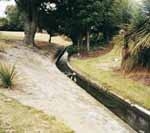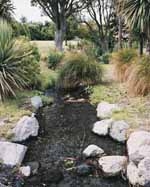PDF of this article (2 MB)

Alastair Suren Eric Graynoth Barry Biggs Shelley McMurtrie Rachel Barker
Stream restoration in Christchurch is turning drains into living streams.
Have you ever thought what happens when it rains in a city? Rainwater and oily road grime mix into a greasy cocktail, causing traffic accidents on slippery roads. Water and debris quickly flow off impervious roads, carparks and roofs. Stormwater drains can become blocked, causing localised flooding. Stormwater is often conveyed to small streams, which run dirty as the water races to the sea. Flood flows in cities are much higher than in rural streams because cities shed water rapidly from their hard asphalt, concrete and iron surfaces.
To cater for increased flood flows, urban streams have been extensively modified into efficient drains by straightening, and lining with wood or concrete. This is especially true in cities such as Dunedin, Nelson and Auckland, where naturally steep slopes further increase water velocity during floods.
Other urban streams have been modified from what was originally swampland. The City of Christchurch, for example, was established in the mid-1840s in a swampy area, drained by rivers that ran “crystal clear”. These rivers were important mahinga kai for Ngai Tahu, who gathered eels and inanga for food, and who made fibre from flax bushes that grew along the banks. By 1875, however, stream water quality had severely declined. An epidemic of typhoid fever that swept through Christchurch was partly due to lack of a proper sewage scheme, but also reflected the soil’s swampy nature.
In response to public pressure, the Christchurch Drainage Board (CDB) was created in 1875 to remove superfluous subsoil and stormwater from the city, and to dispose of sewage. To fulfil this task, most of the meandering headwater streams of the Avon and Heathcote rivers were channelled and lined with wooden box-piling. Gangs of “stream cleaners” removed instream vegetation to maintain high drainage efficiency.
Although the modifications had the intended result, the drainage channels provided poor habitat for the native plants and animals that originally lived there.
In general, urban streams provide little shelter: animals and plants are easily washed away during floods and there is no cover for fish from predators such as birds. There is also often little vegetation along the banks – either buildings and carparks encroach right to their edges, or streamside vegetation is cleared. Lack of shade can lead to thick growths of algae or water plants. In summer, low flows can lead to high water temperatures and declining oxygen levels. As a result, urban streams often support limited stream life – perhaps just a few eels, and tolerant invertebrates such as snails, midges and worms.
A new view of streams



During the 1990s, the Christchurch City Council (CCC) commenced a series of river enhancement projects throughout the city, reflecting a change in attitude on managing urban streams. The original CDB dogma that “drainage was everything” has been drastically revised and a new focus placed on a stream’s ecological functions. Projects to improve the aesthetic and ecological values of streams are now commonplace in Christchurch.
An essential part of the restoration process has been to compare stream conditions before and after treatment. As part of this monitoring, we selected short reaches (50–100 m) of five streams targeted for enhancement projects. Riparian planting was planned for Nottingham Stream, Steamwharf Stream and Smacks Creek, and a combination of channel naturalisation and riparian planting for Papanui Stream and Jacksons Creek.
In 1995, we collected information on bank and instream habitat conditions, and invertebrate communities at each site, just before the enhancement projects began. Five years later, the same sites were resurveyed.
Effects of enhancement
Stream enhancement involved creating a more diverse range of water depths and velocities in the streams. Bare concrete channels and a sand/gravel bed were replaced by mixtures of gravel and cobbles. Different types of riparian planting increased bank vegetation cover at all sites.
Despite the great changes to stream habitat, we found only small differences in invertebrate communities before and after enhancement. Invertebrates in the enhanced streams were still typical of those found in urban environments – mainly snails (Potamopyrgus, Physa), worms, midges, the amphipod Paracalliope, and purse-cased caddisfly Oxyethira. Communities were generally species-poor, and lacked sensitive mayflies, stoneflies and most types of caddisfly.
The lack of change could simply reflect the fact that other invertebrate taxa outside the urban watershed are too far away to find these enhanced “islands” of good habitat (see Bouncing back). Another possibility (highlighted by NIWA FRST-funded research in Auckland) is that the stream sediment in Christchurch may contain high levels of heavy metals such as copper, lead and zinc, as well as some hydrocarbon compounds that can be toxic to some invertebrates. NIWA and the CCC are currently investigating this possibility.
Changes good for fish
Changes to fish communities were much more pronounced. Although we did not survey fish in the streams before they were enhanced, we compared fish populations in enhanced reaches with unchanged reaches in the same streams.
In the enhanced section of Steamwharf Stream, shortfinned eel densities were 1.5 times higher and inanga were found only in the enhanced section. In Nottingham Stream shortfinned eel densities increased by 1.6 times, and longfinned eels were present only in the enhanced section. In Papanui Stream, where there had been both bank and channel enhancement, densities of bullies, shortfinned eels and longfinned eels were 5, 6 and 7 times higher, respectively, than in the control section. Finally, in Jacksons Creek, no fish were found in either control or enhanced sections of the stream. Lack of fish here reflected extensive piping of the flow in the lower reaches, obstructing upstream migration.
Overall then, enhancement activities in these five Christchurch streams have resulted in bigger fish populations and greater habitat diversity. Christchurch City Council is committed to the philosophy of living streams, and stream enhancement activities continue to be a common feature in the Garden City.
Teachers: this article can be used for Biology L7 A.O. 7.3a and Science: Living World L7 A.O. 4. See other curriculum connections at www.niwa.co.nz/pubs/wa/resources
Alastair Suren, Eric Graynoth and Barry Biggs are based at NIWA, Christchurch; Shelley McMurtrie is a consultant ecologist with EOS Ecology Ltd; Rachel Barker is with the Christchurch City Council Parks & Waterways Unit.
Urban stream restoration: an essential economy?
In New Zealand – as in other regions such as the UK, Denmark and North America – there is increasing interest in stream restoration as people place greater value on healthy, productive river ecosystems. To date, most effort has focused on restoring the riparian (streambank) zone in both rural and urban streams.
There have been few attempts to restore habitat structure in New Zealand urban streams. This may reflect low recognition in the past of the importance of good habitat to support healthy ecosystems, a perception that habitat restoration is very costly, and perhaps a lack of technical knowledge on how to implement restoration.
But this situation is rapidly changing. Firstly, there is widespread understanding that water alone does not create a healthy ecosystem. Secondly, many urban streams already require costly maintenance (for example when supporting structures in box drains collapse).
Recent work by the Christchurch City Council Parks & Waterways Unit suggests that enhancing streams by contouring the banks and planting riparian vegetation could cost as little as 10–20% of the cost of piping the stream. Enhanced reaches retain their drainage role, but also provide ecological, recreational and aesthetic assets to the city landscape. Thus, instead of being an expensive luxury, stream restoration could be an essential economy if channel maintenance work is necessary on existing urban streams.
The CCC has recently released “Waterways, wetlands and drainage guide (Ko Te Anga Whakaora mo Nga Arawai Repo)” to help both planners and developers with stream restoration projects. Copies are available from
Parks & Waterways Unit Christchurch City Council PO Box 237 Christchurch Phone +64 3 941 8872 Fax +64 3 941 8987 waterways&[email protected]
